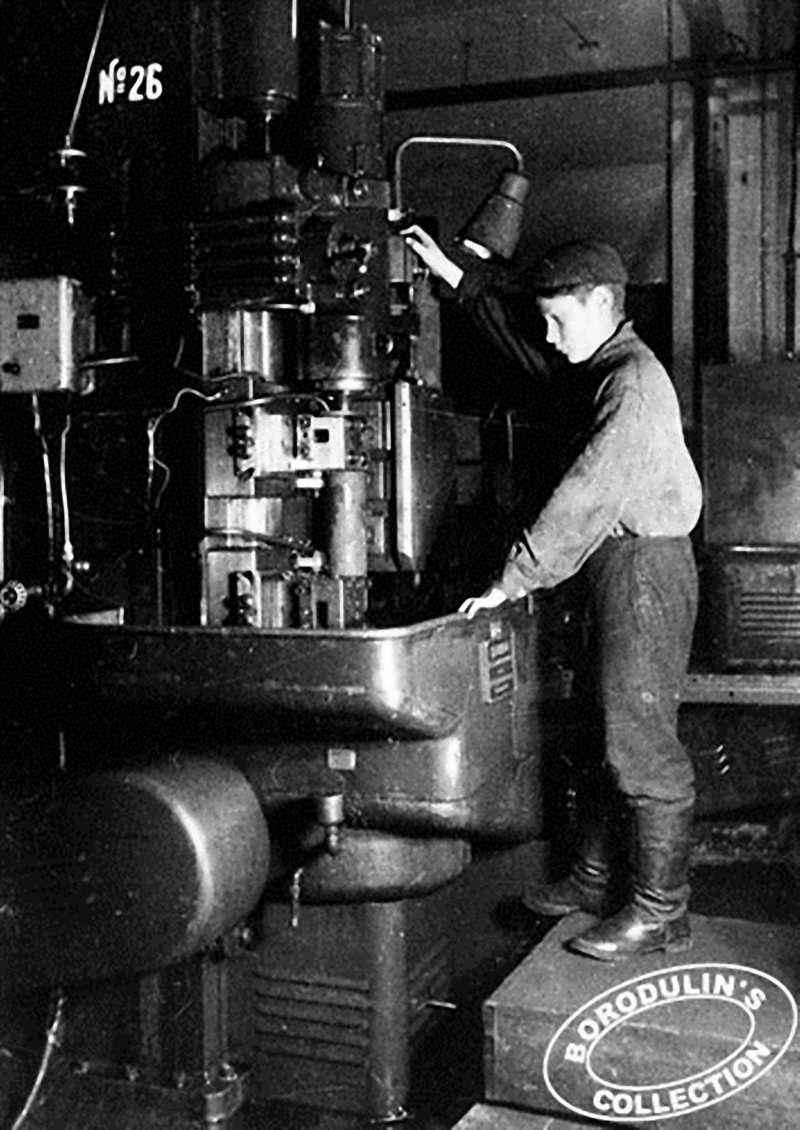
World War II Soviet War Economy: Work Force--Youth

Figure 1.--This Soviet boy is working in a war industry in a factory. A caption says he replace his father who was frafted. We are not sure thisas true or hyprbole, but if true it suggests tht boys were recruited infirmlly at thecfactiry level. He looks to be about 13-years old. Notice how he has to stand on a box to reach the cintrols.
|
|
The other major group which filled in the places of workers who had volunteered or were drafted for military service were youth, mostly but not enirely teenagers. The role of women in the Soviet war economy is very well documented. The role of youth is less well documented. Like women, many children volunteered for war service, both military service and labor service. They were more or less 'adopted' by combat units. Here patriotism was a factor, but not the only factor.
We think many children who joined the military, especialkly the younger children did so in the field. Often they had lost their parents becuse of German military operations. Labor service was more organized and in rear areas. A major problem for the Soviets was food supplies. The Germans during the first month of Barbarossa occupied much of the country's best agicultural land. Not only were Soviet citizens starved in German occupied areas, but some 1-2 million Soviets in the unoccupied areas died as a result of starvation and related illiness, and this does not include surrounded Lenningrad. [Collingham, p. 317.] Soviet children during the War received special rations when available, including milk. This changed when the child turnbed 12 years of age. Despite the caloric needs of teenagers, they received the lowest rations of any population group as they were reclassified as 'dependents'. The ration was so low that they faced starvation. The only way to survive was to become a soldier or a worker. Soldiers and Workers received higher rations, epecially those involved in heavy industry. [Collingham, p. 329.] As a result, boys below military age did their best to become industrial workers, especially jobs in heavy industry. This seems to have been done informally at the factiry level. In which case the biys could stay hme. In other cases they eem to have been recruited en masse and disoarched to factories in the East, including the new factiries opened with the machinry evacuared from areas in the path of advance of German military operations. Of course children could not relpace men in all joibs. Sometimes minimal changes sufficed, such as boxes the youth could stabd on to reach contrls and levers. In other cases the changes were more difficult.
Sources
Collingham, Lizzie. The Taste of War: World War II and the Battle for Food (Penguin Books: New York, 1962), 634p.
Erickson, John. "Soviet women at war," in Jon Garrand and Carol Garrand, eds. World War II and the Soviet People: Selected Papers from the Fourth World Congress for Soviet and East European Studies Harrogate, 1990, (St. Martin's Press: New York, 1993), pp. 50-76.
CIH--WW II

Navigate the CIH World War II Section:
[Return to Main Soviet war economy page]
[Return to Main Soviet World War II home front page]
[Return to Main Soviet World War II war production page]
[Return to Main World War II country food policies]
[Return to Main Soviet World War II page]
[Return to Main World War II country page]
[Biographies]
[Campaigns]
[Children]
[Countries]
[Deciding factors]
[Diplomacy]
[Geo-political crisis]
[Economics]
[Home front]
[Intelligence]
[POWs]
[Resistance]
[Race]
[Refugees]
[Technology]
[Bibliographies]
[Contributions]
[FAQs]
[Images]
[Links]
[Registration]
[Tools]
[Return to Main World War II page]
[Return to Main war essay page]
Created: 7:38 PM 1/31/2015
Last updated: 7:38 PM 1/31/2015



